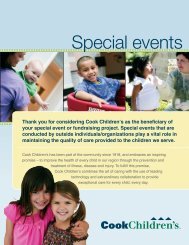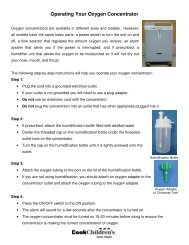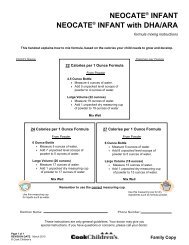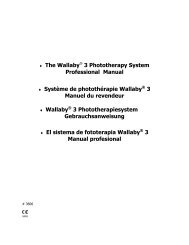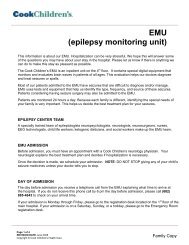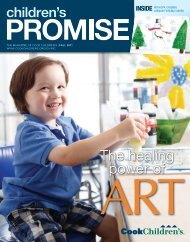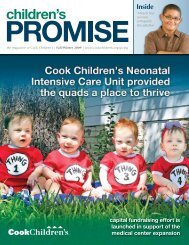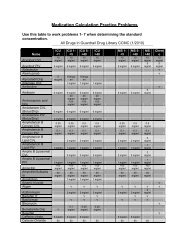inside this issue: Deep Brain Stimulation life after ... - Cook Children's
inside this issue: Deep Brain Stimulation life after ... - Cook Children's
inside this issue: Deep Brain Stimulation life after ... - Cook Children's
You also want an ePaper? Increase the reach of your titles
YUMPU automatically turns print PDFs into web optimized ePapers that Google loves.
Sam’s surgerylasted eighthours, withhim consciousthe majorityof the timewhich allowsthe physiciansto betterdetermine hisprogress andhelps ensureaccurateplacement ofthe deep brainstimulators.medical device sometimes referred to as abrain pacemaker. The electrodes deliver constantsmall electrical impulses to a small region ofthe brain, providing remarkable therapeuticbenefits for otherwise treatment-resistantmovement disorders. The majority of patientstreated at <strong>Cook</strong> Children’s have been fordystonia, but the surgery also helps with othermovement disorders including Parkinson’sdisease and tremors.“We are doing as much as anybody andmore than most in the country when it comesto improving children’s lives,” Dr. Marks said.“We continue to expand our offerings. Wecontinue to push the limits of treatment. In thefuture we will have the ability to treat morechildren and more complex neurologicaldiseases and make them even better. I’m reallyexcited about our ability to bring these newand innovative approaches to solving somevery complex <strong>issue</strong>s.”Sam’s first visit at <strong>Cook</strong> Children’s occurredon the Tuesday before Thanksgiving in 2007,when he met Dr. Acosta. “Sam and Dr. Acostaformed a strong and immediate bond. For us,Dr. Acosta was heaven sent,” Debbie said.After a conference with the <strong>Cook</strong> Children’sneurologists, neurosurgeon and the Gladenfamily, including Sam, the decision was madeto have the DBS surgery.“Dr. Honeycutt explained to Sam exactlyhow the surgery would go, pretty much step bystep,” Kent said. “He explained to him what itsounded like. He told him it would sound likea jet engine in his head. We decided the prosoutweighed the cons.”“The concern is that if you do not havethe surgery, the dystonia will continue toprogress through his body because of his age,”Dr. Acosta said. “The surgery has the potentialto slow the progression.”The DBS program at <strong>Cook</strong> Children’s has adedicated group of more than 25 involved teammembers including neurosurgeons, neurologists,anesthesiologists, nurses, therapists, techniciansand Child Life specialists, who are committed tothe development of the program and the care ofpatients. Sam’s surgery lasted eight hours, withhim conscious the majority of the time whichallows the physicians to better determine hisprogress and helps ensure accurate placement ofthe deep brain stimulators. Throughout theprocess, a Child Life specialist, Kristin LaBoon,stayed with Sam to help keep him calm and tocomfort him through the surgery.The extensive involvement of the Child Lifespecialist is an important and unique aspect ofthe <strong>Cook</strong> Children’s DBS program that really setsthe program apart from other programs. ChildLife helps explain the surgery to patients at alevel they will understand. Child Life meets withpatients the day before the surgery to establish arelationship with them.“Child Life has been huge,” Dr. Acosta said.“They are with the patient from start to finish.They have a very calming effect on the patient.It allows the neurosurgeons, neurologists andall others involved in the case to focus on theircritical aspect of the case, while Child Lifefocuses on the child’s mind and spirit, makingsure the child is comforted.”The family believed hoping for Sam’s foot toreturn to normal was too much. They simplywanted to see their little boy be better, feel lesspain and maybe walk without as much of alimp. But they got so much more.The DBS surgery allowed Sam to stop takingthe painful Botox injections, he no longer wearsthe bulky brace that goes up to his knee, and heno longer takes the medication that left himgroggy. “In Sam’s case, we could not have askedfor a better result,” Dr. Acosta said.Kent and Debbie said they have their happyboy back. Sam, an avid sailor and Boy Scout,has become active again, even participating in agame of pick-up football now and then.“We have made it through all of <strong>this</strong> and wefeel so blessed for the people who we havecome in contact with at <strong>Cook</strong> Children’s, whohave taken care of Sam,” Debbie said. “It’s beenan amazing trip for our family. But one that inthe end was all worth it, thanks to the excellentDBS program at <strong>Cook</strong> Children’s.”Would you expect anything less than a happyending from the debut of a star like Sam Gladen?Remember his name.above left:The <strong>Cook</strong> Children’s <strong>Deep</strong><strong>Brain</strong> <strong>Stimulation</strong> team.06 cook children’s promise – the magazine of <strong>Cook</strong> Children’sWinter 2008 07



